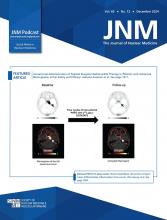TO THE EDITOR: In the article “Diverse Imaging Methods May Influence Long-Term Oncologic Outcomes in Oligorecurrent Prostate Cancer Patients Treated with Metastasis-Directed Therapy (the PRECISE-MDT Study)” (1), 2 propensity score–matched cohorts of patients who underwent metastasis-directed therapy (MDT) guided by either [68Ga]Ga-PSMA-11 or [18F]F-PSMA-1007 PET/CT were compared (n = 44 for each). The use of [68Ga]Ga-PSMA-11 as the guide for MDT was associated with significantly increased median progression-free survival (PFS) (41.5 mo vs. 22.4 mo; hazard ratio, 0.51; P < 0.05) and median PFS2 (not reached vs. 30.3 mo; hazard ratio, 0.24; P < 0.005) compared with [18F]F-PSMA-1007. The 2 cohorts appear to have well-balanced clinical, imaging, and treatment characteristics.
As a basic premise, the detection sensitivity of both [18F]F-PSMA-1007 PET and [68Ga]Ga-PSMA-11 PET is reported to be equivalent in many publications, as they have the same binding moiety (2–4). Furthermore, in a prospective intraindividual masked comparison of [18F]F-PSMA-1007 PET and [68Ga]Ga-PSMA-11 PET, [18F]F-PSMA-1007 demonstrates higher uptake within involved nodes and distant metastases (5). Minimal excretion in urine on [18F]F-PSMA-1007 PET successfully reduces equivocal findings around the urinary tracts or bladder. Therefore, it is hard to believe that there are significant differences in PFS and PFS2 reported in this paper between [68Ga]Ga-PSMA-11 and [18F]F-PSMA-1007 PET for MDT guidance.
These findings are considered to be due to the retrospective design, which includes an unbalanced setting with some hidden heterogeneous background conditions or concurrent treatment contents. First, even though there is no significant difference after performing propensity score matching, it seems that patient conditions are slightly disadvantageous for [18F]F-PSMA-1007. When comparing the characteristics of the patients between the 2 cohorts (Table 3 in the publication), a slightly higher number of patients with an initial AJCC stage IV (6 [13.64%] vs. 2 [4.54%]), fewer patients who underwent surgery in primary treatment (34 [77.27%] vs. 40 [90.91%]), and slightly higher numbers of patients with 3–5 metastatic lesions (4 [9.09%] vs. 2 [4.54%]) and bone or visceral metastasis (16 [36.36%]/1 [2.27%] vs. 12 [27.27%]/0 [0.00%]) were observed in the [18F]F-PSMA-1007 cohort than in the [68Ga]Ga-PSMA-11 cohort.
Second, the details of the concurrent systemic treatment in addition to MDT have not been described. The authors mentioned in the discussion that they did not consider the type and duration of androgen deprivation therapy before MDT in the matching process. If there is a significant difference in this point, it could lead to a substantial difference in oncologic outcomes, such as PFS and PFS2. Additionally, there may be differences among facilities in the sophistication of MDT implementation and in determining the extent of irradiation. Therefore, there is a high possibility that the aggressiveness of the treatment plan differed between the 2 cohorts, significantly affecting the oncologic outcomes.
Third, as the authors wrote in the discussion, the lack of a central imaging review may have introduced heterogeneity in interpretations and potentially affected MDT efficacy. A higher incidence of unspecific bone uptake (UBU) was reported in [18F]F-PSMA-1007; however, experienced reporting physicians can adjust for UBU findings, and there is no critical issue in the real-world setting (6). Ultimately speaking, irradiation to false-positive lesions did not affect the oncologic outcome. Therefore, it is very unlikely that UBU affected the oncologic outcomes.
In conclusion, the results reported by Bauckneht et al. are likely subject to many hidden biases, including heterogeneous concurrent systemic treatment. A head-to-head comparison should be conducted in a prospective, randomized, masked setting to generate high-quality evidence.
DISCLOSURE
No potential conflict of interest relevant to this article was reported.
Tadashi Watabe
Graduate School of Medicine, Osaka University Osaka, Japan
E-mail: watabe.tadashi.med{at}osaka-u.ac.jp
Footnotes
Published online Oct. 17, 2024.
- © 2024 by the Society of Nuclear Medicine and Molecular Imaging.
REFERENCES
- Received for publication August 30, 2024.
- Accepted for publication September 9, 2024.







